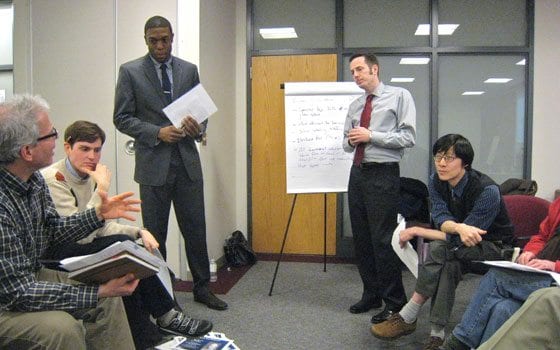
The Boston Transportation Department (BTD) held a public meeting last week on plans to redesign Melnea Cass Boulevard, the fast-paced thoroughfare in Lower Roxbury that will soon see new retail and residential development at some of its key intersections.
About 40 people attended the meeting, the third in a series of presentations and brainstorming sessions on how to make the boulevard more pedestrian- and bicycle-friendly while still accommodating heavy automobile, truck and public transit traffic. State Reps. Gloria Fox and Byron Rushing were in attendance, as well as District 7 City Councilor Tito Jackson and representatives from the offices of state Sen. Sonia Chang-Diaz and City Councilor-at-Large Felix Arroyo.
The meeting was one step in a continuing process of creating a vision and plan for an improved boulevard, organizers said, building on earlier meetings held in October and December.
“We started with a view from 30,000 feet up. Now we’re a little closer in. We’re going to keep getting closer until we have drawings we can look at in inches,” said Patrick Hoey, BTD senior transportation planner and project manager for the Melnea Cass redesign. A tentative timeline indicated a goal of “gaining consensus” on a design by summer 2012.Hoey gave a rough estimate that the project could be complete in about two years.
The BTD, as lead agency on the project, aims to incorporate the city’s new “Complete Streets” strategy as well as the goals of the Roxbury Strategic Master Plan (RSMP) and the state-devised Urban Ring project.
The Complete Streets approach focuses on the needs of pedestrians, bicyclists and transit users as well as drivers, and on environmentally sustainable design.
The RSMP emphasizes economic development for Roxbury and strong community involvement in land use planning. Among the RSMP’s stated goals are to make Melnea Cass Boulevard “more inviting for pedestrians in order to help reduce the perception of a divide between Upper and Lower Roxbury.”
The planned Urban Ring is a roughly circular transit corridor linking Boston and neighboring cities and connecting the “spokes” of existing MBTA routes. Melnea Cass Boulevard would be one part of this corridor.
The Ring plan adds Bus Rapid Transit (BRT), a fast bus system with high-capacity vehicles, widely spaced stops and dedicated bus lanes. The full Urban Ring implementation is now on hold due to Massachusetts Department of Transportation (MassDOT) and MBTA funding shortages, but the Melnea Cass redesign plans will include dedicated bus lanes that can accommodate existing transit and future BRT service.
At a December meeting, community members devised their own wish lists in small-group breakout sessions, filling flip charts with priorities for an improved boulevard. Several themes emerged: pedestrian safety and comfort, clean and well-maintained properties, calmer/slower traffic, preservation and addition of trees, better lighting, and integration of the street and its commercial areas with Dudley Square.
At the March 15 meeting, members of the project’s outside consultant team recapped those themes and discussed how they might be implemented in various parts of the long boulevard.
Another key topic was where to place the new dedicated bus lanes — at curbside or along a center median.
Nick Jackson, a senior planner with Toole Design Group, described the main features of each option.
Center-located bus lanes and stations allow faster bus travel, said Jackson, and are the preferred option in Urban Ring plans. Passengers load and unload at stations built on a center median. The median becomes a safe halfway point for pedestrians crossing the street.
With curbside bus lanes, like those used by the Silver Line on Washington Street, bus traffic can be slowed by right-turning and double-parked cars. Streets with curbside bus loading have less room for street parking and provide no automatic pedestrian refuge in the center.
Another option used in some cities is to have bus lanes in two directions placed on one side of the street — an option “not very doable here,” Jackson said.
For both center and curbside bus lane examples, the design drawings show Melnea Cass Boulevard with two lanes of general traffic in each direction and an added lane for street parking on each side.
In small-group sessions following the presentation, attendees listed current priorities and questions and mulled over the bus lane topic. By the end, it appeared that in most groups people generally leaned toward the center-median option, though one presenter said her group included someone who was against BRT lanes in any form.
One group had worried that center bus lanes would cause increased danger or difficulty with pedestrian street crossings, but then considered the example of the Green Line T stops on Beacon Street in Brookline and agreed it is possible to satisfactorily accommodate transit lanes, street parking and safe traffic crossings.
Some groups kept their eyes on economic development, suggesting that signs should be added pointing the way to Dudley Square, and that new businesses at Melnea Cass Boulevard’s intersections should have entrances facing the boulevard.
“We have to encourage people to stop, and to shop,” one presenter noted.
A few people said they hoped traffic calming measures would not stifle traffic flow for drivers.
Rep. Rushing, who was quick to express discontent at the first meeting when presenters did not address key aspects of past community activism and planning, had a positive assessment this time.
“I think they’re right on track,” he said, speaking after the meeting. “There is more consensus than disagreement.”






